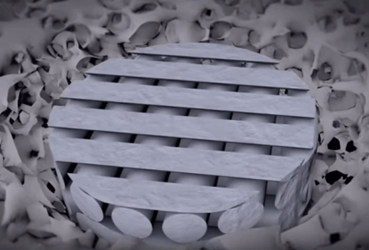Scientists Develop Bio-Glass Implant To Regenerate Cartilage
By Jof Enriquez,
Follow me on Twitter @jofenriq

Researchers from Imperial College London and the University of Milano-Bicocca have developed a new bio-glass material with properties similar to those of real cartilage, which is notoriously difficult to repair due to its lack of blood supply and slow metabolism compared to other tissues. The team plans to use its material to make 3D-printed implants that stimulate the body to regenerate cartilage in knees and the spine.
The bio-glass is a combination of two components: inorganic silica and organic polymer polycaprolactone. Akin to natural cartilage tissue, the material is flexible, strong, durable, and resilient. Also, the synthetic material can be made into a biodegradable ink, which makes it possible for researchers to 3D-print custom scaffolds that can be surgically implanted to regenerate damaged cartilage cells in knees, or replace worn-out cartilage discs between vertebrae. When implanted, the bio-glass material will act as a scaffold that encourages cartilage cells to grow through microscopic pores. The bio-glass will eventually degrade safely in the body, as newly-grown cartilage takes over.
“Bio-glass has been around since the 1960s, originally developed around the time of the Vietnam War to help heal bones of veterans, which were damaged in conflict. Our research shows that a new flexible version of this material could be used as cartilage-like material," said Professor Julian Jones of the Department of Materials at Imperial College, one of the developers of the bio-glass, in a press release.
“This novel formulation and method of manufacture will allow Julian and his team to develop the next generation of biomaterials. Today, the best performing artificial joints are more than a thousand times stiffer than normal cartilage. While they work very well, the promise of a novel class of bearing material that is close to nature and can be 3D printed is really exciting,” added Professor Justin Cobb, Chair in Orthopaedic Surgery at Imperial’s Department of Medicine. “Using Julian's technology platform we may be able to restore flexibility and comfort to stiff joints and spines without using stiff metal and all its associated problems.”
The research team has patented its technology and is planning to conduct clinical trials and to develop a surgical method for inserting the implants, according to the release. The team also is talking to potential partners to help it refine its 3D-printing techniques.
Cartilage regeneration technologies are being targeted by big medical device companies to augment their joint repair offerings, and to address growing demand for patients with early-stage osteoarthritis who have not responded well to conservative treatment, but are not yet candidates for full joint replacement procedures.
Early this year, Smith & Nephew bought BST-CarGel, developer of a biopolymer-based solution that is mixed with a patient’s blood and implanted into the joint following a microfracture procedure. The implant acts as a scaffold, adhering to the cartilage surface to stabilize the blood clot while new cartilage is regenerated.
At around the same time, Johnson & Johnson invested in startup CartiHeal Ltd., developer of the Agili-C implant, which is a porous, resorbable tissue regeneration scaffold for the treatment of focal articular cartilage and/or osteochondral defects.
